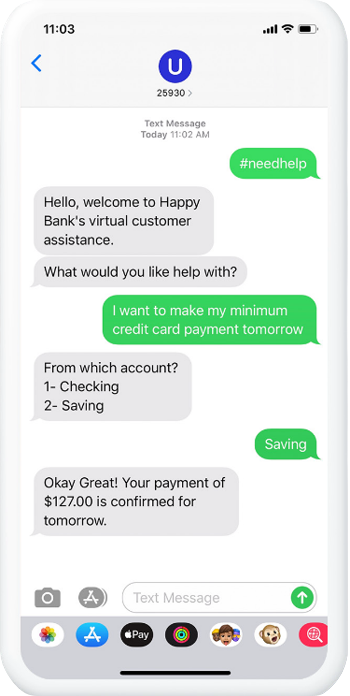
COVID-19 turned everyday life upside down, and everyday work too. Yet work goes on. Companies need to connect with their customers as much as ever, maybe more. The question is how.
We recently hosted a webinar on just this topic—how businesses are using conversational AI to engage customers during the COVID crisis, and just as importantly, why. For those who couldn’t join, here are some of the highlights.
Customer inquiries have spiked during the pandemic. In one study by Customer Contact Week, 32% of the companies surveyed reported an increase in inbound requests, and 10% of those surveyed saw a 50% jump in volume.
For businesses, this is a real dilemma. They need to keep customers happy. But their agents are working from home, where tasks may take longer to complete and Internet connections aren’t always reliable. At the same time, businesses still need to comply with strict regulations governing customer privacy and cybersecurity. Communication channels like email, which might have been fine for casual exchanges in the pre-COVID world, buckle under the strain of everything they’re being asked to do.

One Harvard Business Review study examined a million customer service calls fielded at call centers since the start of the pandemic. It discovered that escalations were up 68%, and overall call length 34%. Calls were not only becoming more numerous, but longer and more complex. Not surprisingly, the study found abandon rates up as well, signaling that customers were losing patience.
Clearly, status quo solutions won’t cut it anymore. Businesses need alternatives, and one of the standouts is conversational AI. This is technology that understands human language, but also understands intent and sentiment, giving it the ability to engage customers with realistic dialogue and react like a human agent.
Unlike human agents, conversational AI doesn’t get tired or impatient. It doesn’t forget facts. It allows businesses to offload high-volume, routine conversations to a bot, giving agents the freedom to focus on higher value formats that require human judgement.
We see enterprises leveraging conversational AI and, more broadly, automation, to power a comprehensive, omnichannel approach to all sorts of customer tasks.
According to a survey from customer-desk software firm Zendesk, customer inquiries via SMS have increased 26% since the start of the pandemic. This is an ideal opportunity for a chatbot powered by conversational AI. The bot can handle routine conversations and automatically pull in a live agent if the discussion gets too complex, or the AI senses that the customer is getting frustrated. Similar bots can be implemented on a company’s website.
With Dynamic Call Deflection, businesses can give customers waiting on hold the option to talk with a digital agent, powered by conversational AI, rather than to wait for a live agent.
Conversational AI and email automation mesh surprisingly well. Companies that receive hundreds of thousands of inbound emails per month can use conversational AI to quickly route them to the most relevant customer service department, or even answer them automatically.
Automation is good, and bots are helpful. But no one wants customer interactions to feel, well, robotic. With conversational AI, businesses get the efficiency of automation with the personal touch of a conversation.
It doesn’t look like businesses will be back to normal anytime soon. They need to automate now, and they need solutions they can implement remotely. Conversational AI platforms that are based in the Cloud or can be implemented by remote teams fit the bill.

Customers have options. They’re impatient. They want—and expect—to engage using the digital channel of their choice, whether that be text, email, or other. conversational AI allows businesses to meet customers where they are, enabling an omnichannel approach that’s automated from beginning to end, while still delivering a friendly and personalized experience.
Remember that need for speed? So-called low-code conversational AI solutions allow business users—what we might call “citizen developers”—to quickly build sophisticated AI-powered workflows without knowing a line of Python or Java. That in turn allows them to quickly launch customized new campaigns, build their own customer journeys and implement the right compliance and security guardrails without having to wait on IT. It’s the breaker of barriers, bringing siloed organizations and departments together.
A survey conducted by AppDynamics found that 88% of technologists and IT professionals rate digital customer experience initiatives as their number-one priority. Conversational AI can be a big part of that strategy. We see customers use it to proactively engage with claimants, subscribers, or patients, to request information or complete routine tasks. And since conversational AI platforms like Ushur easily connect to your CRM and customer-desk systems of record, the data from these interactions can be saved, analyzed and used to improve future customer engagements. The more you use it, the more it learns and the more it can do.
If you’d like to learn more, check out the full webinar and hear Michael Fisher, VP of Product, and Vandana Rao, VP of Customer Growth, talk about how leading organizations are adopting conversational AI today.
